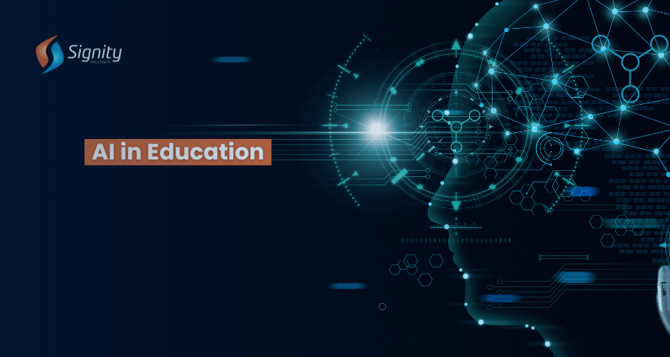AI in Education: Use Cases, Benefits, Solutions, and Implementation
AI in education enhances learning experiences, streamlines administrative tasks, and offers personalized learning. By leveraging AI use cases, benefits, and solutions, educational institutions can become more efficient, accessible, and effective.

Artificial Intelligence (AI) is transforming various sectors, and education is no exception. The integration of AI in education offers innovative solutions that enhance learning experiences, improve administrative efficiency, and provide personalized learning pathways. This article explores the use cases, benefits, solutions, and implementation strategies of AI in education, highlighting the roles of AI development companies, AI development processes, and chatbot development.
Use Cases of AI in Education
Personalized Learning
AI enables personalized learning experiences by analyzing individual student data to tailor educational content and pace to each learner’s needs. AI development companies create adaptive learning platforms that adjust the difficulty level of tasks based on the learner's progress.
Automated Grading
AI can streamline the grading process for multiple-choice, fill-in-the-blank, and even essay-type assessments. This not only saves time for educators but also provides quicker feedback to students.
Virtual Tutors and Chatbots
AI-powered virtual tutors provide students with additional learning support outside of classroom hours. AI development in chatbot development enables the creation of chatbots that answer common student queries, assist with administrative tasks, and provide immediate assistance.
Smart Content Creation
AI can help create and curate educational content. Tools developed by AI development companies can create customized textbooks, generate practice questions, and summarize lessons, ensuring the material is up-to-date and aligned with curriculum standards.
Predictive Analytics
By analyzing data on student performance and behavior, AI can predict future outcomes, identify at-risk students, and suggest interventions to help them succeed.
Administrative Automation
AI can automate administrative tasks such as scheduling, attendance tracking, and managing student records, allowing educators to focus more on teaching and less on paperwork.
Benefits of AI in Education
Enhanced Learning Experience
AI provides a more engaging and interactive learning experience through personalized content and adaptive learning tools developed by AI development companies.
Increased Efficiency
Automation of grading and administrative tasks frees up valuable time for educators, enabling them to focus on instruction and student interaction.
Improved Accessibility
AI-powered tools, such as speech-to-text and language translation, make education more accessible to students with disabilities and those who speak different languages.
Data-Driven Insights
AI offers deep insights into student performance and behavior, helping educators make informed decisions and improve teaching strategies.
Cost-Effectiveness
By automating various tasks and providing scalable learning solutions, AI can help reduce the overall cost of education.
Solutions for AI in Education
Learning Management Systems (LMS)
Integrating AI into LMS platforms can enhance the delivery and management of educational courses. Features include adaptive learning paths, real-time feedback, and analytics, often developed through comprehensive AI development processes.
AI Tutoring Systems
These systems provide students with 24/7 access to tutoring assistance, helping them understand complex subjects and complete assignments. AI development companies play a key role in creating these intelligent tutoring systems.
Content Recommendation Systems
AI algorithms recommend relevant resources and activities based on a student’s learning history and preferences, promoting continuous learning.
Intelligent Classrooms
Intelligent classrooms equipped with AI tools can offer a dynamic and responsive learning environment. Features include smart boards, voice recognition, and automated attendance systems.
Implementation Strategies
Define Objectives
Clearly outline the goals of integrating AI in your educational institution. Determine whether the focus is on personalized learning, administrative efficiency, or improving accessibility.
Choose the Right Tools
Select AI tools and platforms that align with your educational objectives and are compatible with your existing systems. Partnering with an AI development company can help ensure you choose the right solutions.
Pilot Programs
Start with pilot programs to test the effectiveness of AI tools. Collect feedback from educators and students to make necessary adjustments.
Training and Support
Provide comprehensive training for educators and administrators on how to use AI tools effectively. Continuous support and professional development are crucial for successful implementation.
Data Privacy and Security
Ensure that all AI implementations comply with data privacy regulations. Protecting student data should be a top priority.
Monitor and Evaluate
Regularly assess AI's impact on educational outcomes and administrative processes. Use this data to refine and improve the AI implementation strategy.
Conclusion
AI in education enhances learning experiences, streamlines administrative tasks, and provides personalized education. Understanding its use cases, benefits, solutions, and implementation strategies allows institutions to create more efficient, accessible, and effective educational environments.
 As AI evolves, its role in education will expand, offering innovative solutions to meet diverse learner and educator needs.
As AI evolves, its role in education will expand, offering innovative solutions to meet diverse learner and educator needs.


%201-1.webp)


.png?width=344&height=101&name=Mask%20group%20(5).png)


















